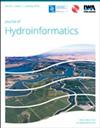使用中心性导向多目标优化的配水网络传感器安置
IF 2.2
3区 工程技术
Q3 COMPUTER SCIENCE, INTERDISCIPLINARY APPLICATIONS
引用次数: 0
摘要
摘要:本文介绍了一种多目标优化方法,用于解决配水网络中用于污染检测的有效传感器放置问题。一个重要的问题是,如何在不失去监控整个系统的能力的情况下,确定所需传感器的最小数量。在本研究中,我们采用了中心性突变的NSGA-II多目标优化方法。该方法有两个目标,即最小化预期检测时间和最大化检测网络覆盖(计算检测到的水污染事件的数量),在一个中等规模的基准问题(129个节点)上进行了测试。由此得出的帕累托前沿表明,只需部署几个传感器(例如,从一个传感器增加到三个传感器),检测网络的覆盖范围就可以显著提高。然而,在达到一定数量的传感器后(如20个传感器),进一步增加传感器数量的效果并不明显。此外,结果证实,40-45个传感器(即节点总数的31 - 35%)将足以完全监控基准网络,即检测任何污染物入侵事件,无论它出现在网络中的哪个位置。本文章由计算机程序翻译,如有差异,请以英文原文为准。
Sensor placement in water distribution networks using centrality-guided multi-objective optimisation
Abstract This paper introduces a multi-objective optimisation approach for the challenging problem of efficient sensor placement in water distribution networks for contamination detection. An important question is how to identify the minimal number of required sensors without losing the capacity to monitor the system as a whole. In this study, we adapted the NSGA-II multi-objective optimisation method by applying centrality mutation. The approach, with two objectives, namely the minimisation of Expected Time of Detection and maximisation of Detection Network Coverage (which computes the number of detected water contamination events), is tested on a moderate-sized benchmark problem (129 nodes). The resulting Pareto front shows that detection network coverage can improve dramatically by deploying only a few sensors (e.g. increase from one sensor to three sensors). However, after reaching a certain number of sensors (e.g. 20 sensors), the effectiveness of further increasing the number of sensors is not apparent. Further, the results confirm that 40–45 sensors (i.e. 31 − 35% of the total number of nodes) will be sufficient for fully monitoring the benchmark network, i.e. for detection of any contaminant intrusion event no matter where it appears in the network.
求助全文
通过发布文献求助,成功后即可免费获取论文全文。
去求助
来源期刊

Journal of Hydroinformatics
工程技术-工程:土木
CiteScore
4.80
自引率
3.70%
发文量
59
审稿时长
3 months
期刊介绍:
Journal of Hydroinformatics is a peer-reviewed journal devoted to the application of information technology in the widest sense to problems of the aquatic environment. It promotes Hydroinformatics as a cross-disciplinary field of study, combining technological, human-sociological and more general environmental interests, including an ethical perspective.
 求助内容:
求助内容: 应助结果提醒方式:
应助结果提醒方式:


